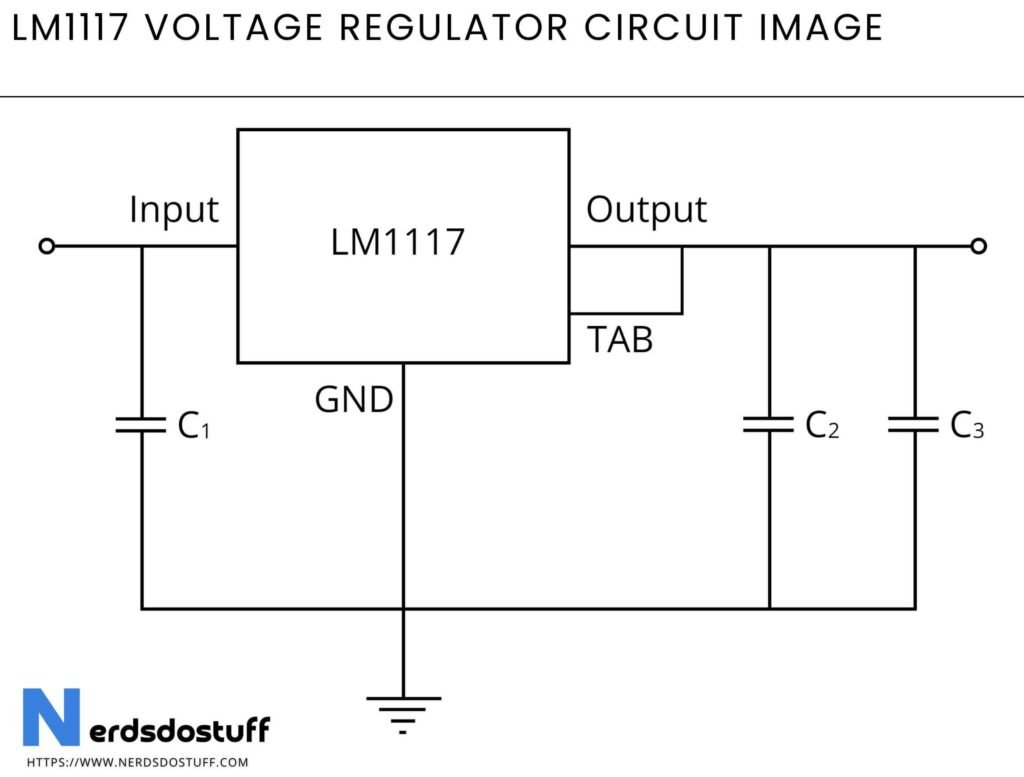What is LM1117 Voltage Regulator ?
The LM1117 is a low dropout voltage regulator (LDO) integrated circuit (IC) that provides a stable output voltage with low dropout voltage, making it suitable for applications where input voltage is close to the desired output voltage. It is available in various fixed output voltage versions and is commonly used as a reliable and efficient voltage regulator in electronic circuits.
The LM1117 operates in a similar manner to other linear voltage regulators but with the advantage of having a lower dropout voltage, meaning it can regulate the output voltage even when the input voltage is only slightly higher than the desired output voltage. This feature makes the LM1117 ideal for battery-powered applications and other low voltage applications where efficiency and reliability are critical.
LM1117 Voltage Regulator Circuit

Features of LM1117 Voltage Regulator
| Feature | Description |
|---|---|
| Input Voltage Range | 4.2 V to 15 V (Typical) |
| Output Voltage Range | Fixed output voltage options available (e.g., 3.3 V, 5 V) |
| Output Current | Up to 800 mA continuous (Depending on package and thermal conditions) |
| Dropout Voltage | Typically 1.2 V at 800 mA output current |
| Line Regulation | 0.2% typical (Over entire temperature range) |
| Load Regulation | 0.4% typical (Over entire temperature range) |
| Ripple Rejection | 70 dB typical (Over entire temperature range) |
| Temperature Range | -40°C to +125°C (Operating) |
| Thermal Shutdown | Yes |
| Short-Circuit Protection | Yes |
| Package Types | TO-220, TO-220FP, SOT-223, and other surface-mount packages |
Working of LM1117 Voltage Regulator
- Reference Voltage: The LM1117 contains an internal voltage reference that produces a fixed reference voltage between its input and output pins. This reference voltage serves as a comparison point for regulating the output voltage.
- Pass Transistor: The LM1117 uses a pass transistor to control the flow of current from the input to the output, thereby regulating the output voltage. The pass transistor adjusts its conductivity based on feedback from the output voltage and the reference voltage.
- Voltage Regulation: When an input voltage is applied to the LM1117, it regulates the output voltage by adjusting the pass transistor’s conductivity. If the output voltage falls below the desired level, the LM1117 increases the pass transistor’s conductivity, allowing more current to flow from the input to the output and thus raising the output voltage. Conversely, if the output voltage exceeds the desired level, the LM1117 decreases the pass transistor’s conductivity, limiting the current flow and lowering the output voltage.
- Stability and Protection: The LM1117 incorporates various features such as thermal overload protection, current limiting, and short-circuit protection to ensure safe and reliable operation. These protections safeguard against excessive heat, overcurrent conditions, and short-circuit events, enhancing the regulator’s reliability in various applications.
Applications of LM1117 Voltage Regulator
- Battery-powered Devices
- Embedded Systems
- Mobile Devices
- USB Power Supplies
- IoT (Internet of Things) Devices
- Audio Amplifiers




